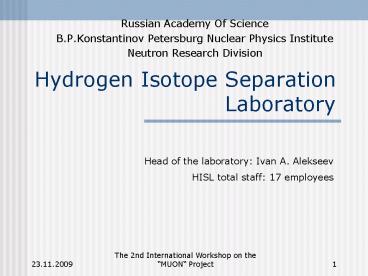Hydrogen Isotope Separation Laboratory - PowerPoint PPT Presentation
1 / 11
Title:
Hydrogen Isotope Separation Laboratory
Description:
B.P.Konstantinov Petersburg Nuclear Physics Institute. Neutron ... High Concentration Heavy Water Samples Spectra (d=206 micron, fluorite, t=33 C) 11/12/09 ... – PowerPoint PPT presentation
Number of Views:860
Avg rating:3.0/5.0
Title: Hydrogen Isotope Separation Laboratory
1
Hydrogen Isotope Separation Laboratory
- Russian Academy Of Science
- B.P.Konstantinov Petersburg Nuclear Physics
Institute - Neutron Research Division
Head of the laboratory Ivan A. Alekseev HISL
total staff 17 employees
2
Activity of the Laboratory
- Full scale studies of various hydrogen isotope
separation methods for the development of heavy
and light water detritiation technology - The scientific guidance and design supervision
for the construction of the reactor PIK heavy
water Detritiation and Deprotization Plant - Computer simulation of the studying processes
- Provision and new procedures development of water
and hydrogen gas isotope analysis - Production of high quality heavy water and
gaseous deuterium - Pilot-scale production deuterium depleted water
(up to 3 orders of magnitude below natural)
3
Semi-industrial Facilities
- Cryogenic distillation (CD)
- The single column of 5.5 m height with the
interchangeable mass exchange sections of
diameter up to 300 mm (the vacuum jacket of 1200
mm diameter) - Helium supply system (4 kW at 20 K) Reflux flow
of HD-D2-DT mixtures in the column - up to 10
kMoles/h - Provided with the systems of deuterium
production, gas compression, cleaning and storage - Water distillation (WD)
- 4 distillation columns of 80 mm diameter and 10 m
height with very high efficiency (HETP 2.5 cm) - Combine electrolysis and catalytic exchange
(EVIO) - 2 exchange columns of 100 mm inner diameter and
height of 6.9 m filled with hydrophobic catalyst
and packing - Electrolysis cells with capacity of 5 m3 H2 (D2)
per hour
4
Separation Factor Is the Magnitude of an
Elementary Separation Effect
Table. The equilibrium separation factors
hydrogen-water isotope exchanges for tritium ?T
and deuterium ?D at 60 ??
- Separation factor for isotopic exchange between
water and hydrogen depends on what molecules are
to be separated - Relatively high values of separation factor at
ordinary conditions make the process of
water-hydrogen isotope exchange attractive for
the different tasks of hydrogen isotope
separation. For comparison separation factor for
water distillation ?H-D1.026 at atmospheric
pressure
5
Demonstration Very High Detritiation Factor With
EVIO Facility
- Repeated contact over catalyst between water
vapour and gaseous hydrogen and counter current
between liquid water and vapour-gas mixture
underlies the CECE process and leads to the
effect of separation multiplying - EVIO facility is under operation now. Heavy
water purification from tritium is successfully
being carried out with the following
characteristics - The achieved separation degree (SD) is more than
2103 - The top product output capacity is about 8
litres per day - Todays results receiving on the column of height
only 7 m do not have any similar ones in the
world
6
The Task of Pilot-scale Production of Deuterium
Depleted Water at PNPI
- Gaseous hydrogen containing deuterium in an
amount about 0.1 ppm is needed - Natural water contains about 150 ppm of
deuterium. Thus needed separation degree (SD) is
1.5103. The total required amount of the product
does not exceed 10 litres. - This is much less intensive task compared to the
separation possibilities of our facilities - EVIO lets to process diluted heavy water waste
contaminated by tritium and produce high quality
heavy water. The achieved SD for D-H in a wide
range of deuterium concentration is about 1105 - The achievable SD for the task of heavy water
conditioning is about 5103 in any of the
existing WD column
7
Possible Ways and Weak Points of the Task Solution
- Any of the above mentioned methods and existing
facilities can be used in principle for the
production of super-light water (0.1 ppm of D) - But according to the required small scale
production only two methods were dealt with - A new laboratory scale installation based on
Combine Electrolysis and Catalytic Exchange
(CECE) process and - One of the existing Water Distillation column
- There are two weak points of this separation task
solution. They mainly concern earlier used (for
heavy water production) equipment - The first is trouble with washing of dead spaces
and - The second is lack of operative analysis that
would allow the tracing of the washing process
8
Isotope Analysis of Water by the method of
IR-spectrophotometry
- Threshold sensitivity to content of protium in
heavy water is 6 ppm. It is due to provided
standard deviation in measurements of cell
transmission (T) which is less than 0.1 - Analogous absorption band with maximum at 2500
cm-1 allow us to analyse small deuterium content
in light water but with threshold sensitivity of
only about 15 ppm
Figure. High Concentration Heavy Water Samples
Spectra (d206 micron, fluorite, t33?C)
9
Computer Simulation of Non Steady-state Water
Distillation Process Using for Deuterium Depleted
Water Production
Expected reboiler and conden-ser (product)
deuterium con-centration variation with time
N300, P100 kPa, G10 litre/h, Vreb.20 litres,
Vcnd.10 litres, Vpac.5 litres
After 3 runs (with duration gt 300 hours) minimum
measured concentration 3.2 ppm was obtained
(after the last run)
10
(No Transcript)
11
Laboratory Scale CECE Process for Deuterium
Depleted Water Production or Conditioning
- Electrolysis cells capacity is 0.5 m3 H2 per hour
- Catalytic Burner capacity is the same - 0.5 m3 H2
per hour - 1 litre of hydrophobic Catalyst - 0.8 wt. Pt
deposited on porous styrene-divinylbenzene
copolymer - 2.5 litres of Packing - stainless steel
spiral-prismatic with size 2.22.20.2 mm - Including such an installation in the structure
of Gas Circulation System would provide a
guarantee of low level deuterium admixture
Burner
Product as gas or as water
Condenser
Water dosing pump
Isotope exchange apparatus
Thermostat
Electrolysis Cells
Waste water































